Taxation Laws Assignment: Analyzing Taxation Laws and Case Studies
VerifiedAdded on 2021/06/18
|12
|2961
|340
Homework Assignment
AI Summary
This assignment analyzes various aspects of taxation laws, primarily focusing on case studies like Arthur Murray (NSW) Pty Ltd v FCT and RIP Ltd. It delves into the interpretation and application of the Income Tax Assessment Act 1997 (ITTA 1997), specifically addressing the treatment of prepaid income, the methods for computing taxable income (earning vs. receipt methods), and the concept of trading stock. The assignment examines the tax implications of advance payments, forfeited payments, and allowable deductions related to trading stock. It also explores the principles established in case law to determine the assessable income of a business and the relevant tax rulings applicable to individuals and companies. The solution provides a comprehensive overview of the legal requirements and their practical implications in the context of the provided case studies, offering insights into how businesses should account for income and expenses for tax purposes.
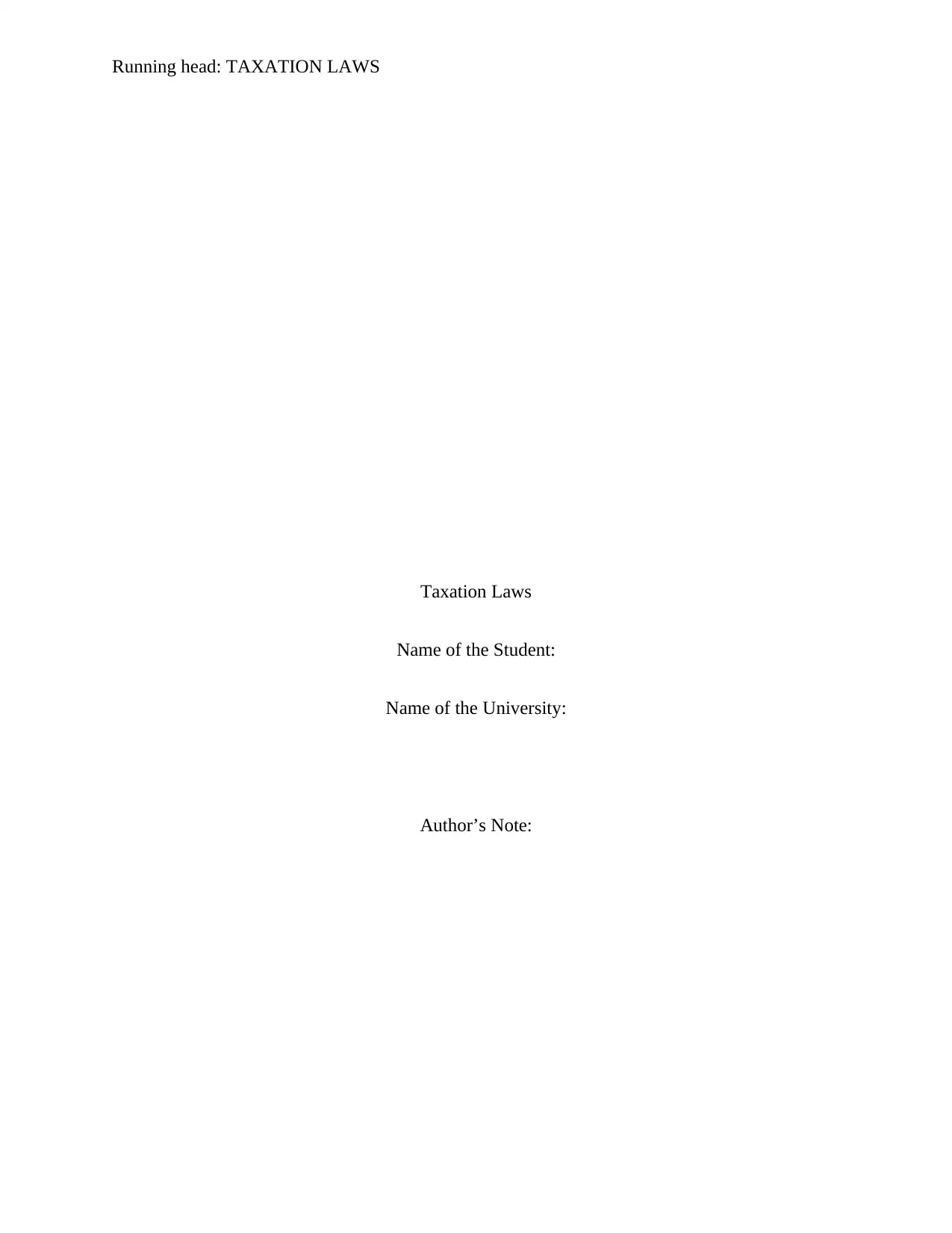
Running head: TAXATION LAWS
Taxation Laws
Name of the Student:
Name of the University:
Author’s Note:
Taxation Laws
Name of the Student:
Name of the University:
Author’s Note:
Paraphrase This Document
Need a fresh take? Get an instant paraphrase of this document with our AI Paraphraser
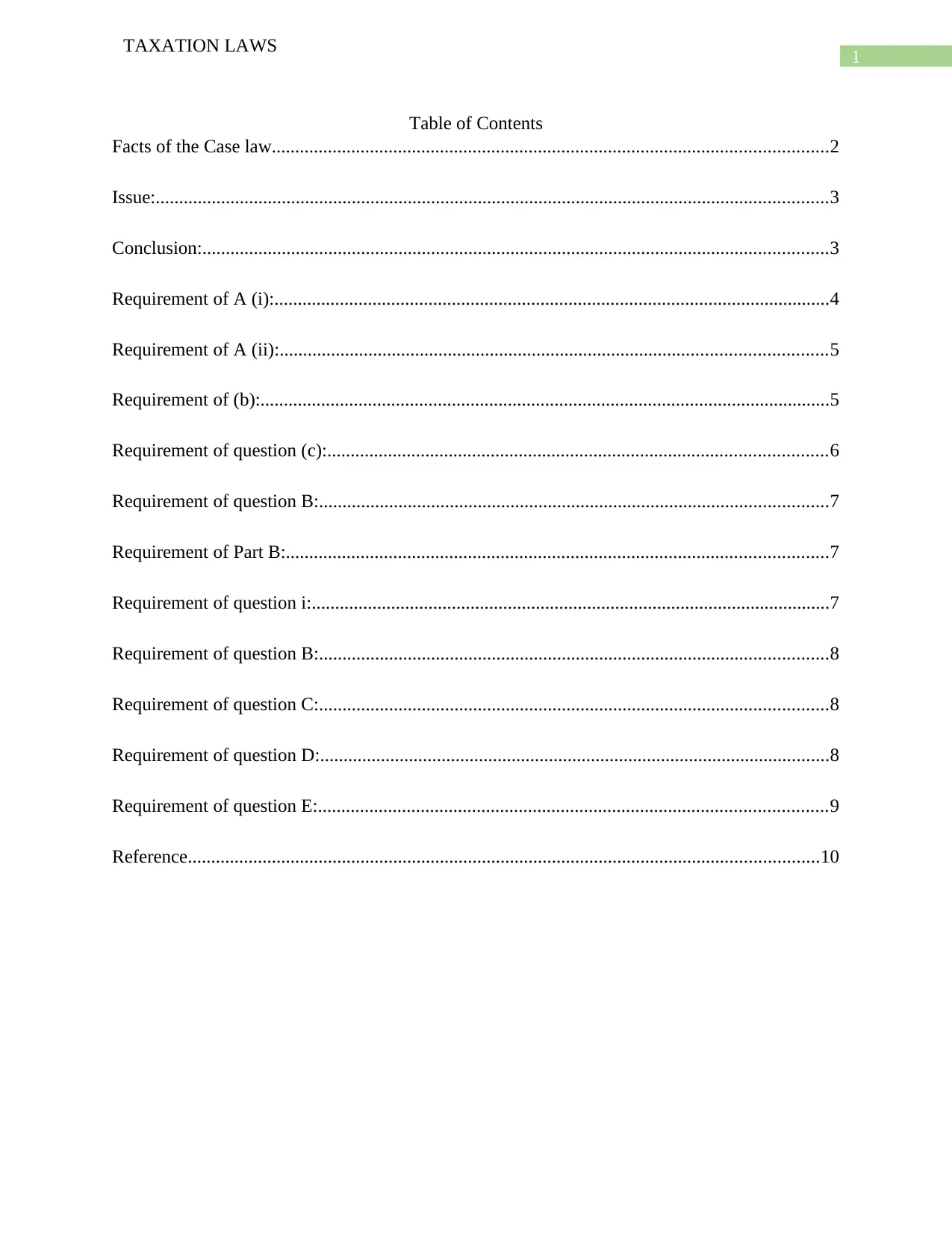
1
TAXATION LAWS
Table of Contents
Facts of the Case law.......................................................................................................................2
Issue:................................................................................................................................................3
Conclusion:......................................................................................................................................3
Requirement of A (i):.......................................................................................................................4
Requirement of A (ii):.....................................................................................................................5
Requirement of (b):..........................................................................................................................5
Requirement of question (c):...........................................................................................................6
Requirement of question B:.............................................................................................................7
Requirement of Part B:....................................................................................................................7
Requirement of question i:...............................................................................................................7
Requirement of question B:.............................................................................................................8
Requirement of question C:.............................................................................................................8
Requirement of question D:.............................................................................................................8
Requirement of question E:.............................................................................................................9
Reference.......................................................................................................................................10
TAXATION LAWS
Table of Contents
Facts of the Case law.......................................................................................................................2
Issue:................................................................................................................................................3
Conclusion:......................................................................................................................................3
Requirement of A (i):.......................................................................................................................4
Requirement of A (ii):.....................................................................................................................5
Requirement of (b):..........................................................................................................................5
Requirement of question (c):...........................................................................................................6
Requirement of question B:.............................................................................................................7
Requirement of Part B:....................................................................................................................7
Requirement of question i:...............................................................................................................7
Requirement of question B:.............................................................................................................8
Requirement of question C:.............................................................................................................8
Requirement of question D:.............................................................................................................8
Requirement of question E:.............................................................................................................9
Reference.......................................................................................................................................10
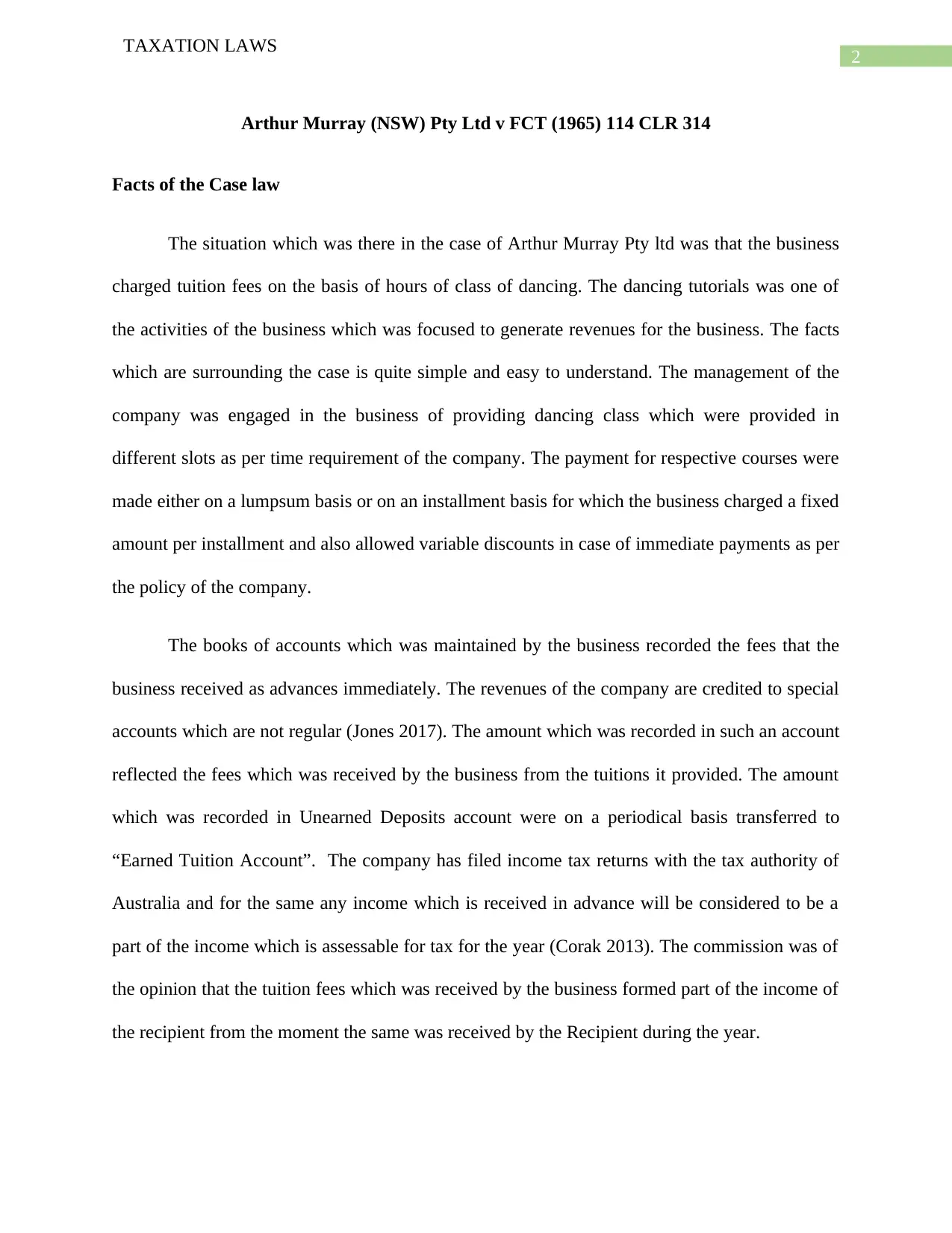
2
TAXATION LAWS
Arthur Murray (NSW) Pty Ltd v FCT (1965) 114 CLR 314
Facts of the Case law
The situation which was there in the case of Arthur Murray Pty ltd was that the business
charged tuition fees on the basis of hours of class of dancing. The dancing tutorials was one of
the activities of the business which was focused to generate revenues for the business. The facts
which are surrounding the case is quite simple and easy to understand. The management of the
company was engaged in the business of providing dancing class which were provided in
different slots as per time requirement of the company. The payment for respective courses were
made either on a lumpsum basis or on an installment basis for which the business charged a fixed
amount per installment and also allowed variable discounts in case of immediate payments as per
the policy of the company.
The books of accounts which was maintained by the business recorded the fees that the
business received as advances immediately. The revenues of the company are credited to special
accounts which are not regular (Jones 2017). The amount which was recorded in such an account
reflected the fees which was received by the business from the tuitions it provided. The amount
which was recorded in Unearned Deposits account were on a periodical basis transferred to
“Earned Tuition Account”. The company has filed income tax returns with the tax authority of
Australia and for the same any income which is received in advance will be considered to be a
part of the income which is assessable for tax for the year (Corak 2013). The commission was of
the opinion that the tuition fees which was received by the business formed part of the income of
the recipient from the moment the same was received by the Recipient during the year.
TAXATION LAWS
Arthur Murray (NSW) Pty Ltd v FCT (1965) 114 CLR 314
Facts of the Case law
The situation which was there in the case of Arthur Murray Pty ltd was that the business
charged tuition fees on the basis of hours of class of dancing. The dancing tutorials was one of
the activities of the business which was focused to generate revenues for the business. The facts
which are surrounding the case is quite simple and easy to understand. The management of the
company was engaged in the business of providing dancing class which were provided in
different slots as per time requirement of the company. The payment for respective courses were
made either on a lumpsum basis or on an installment basis for which the business charged a fixed
amount per installment and also allowed variable discounts in case of immediate payments as per
the policy of the company.
The books of accounts which was maintained by the business recorded the fees that the
business received as advances immediately. The revenues of the company are credited to special
accounts which are not regular (Jones 2017). The amount which was recorded in such an account
reflected the fees which was received by the business from the tuitions it provided. The amount
which was recorded in Unearned Deposits account were on a periodical basis transferred to
“Earned Tuition Account”. The company has filed income tax returns with the tax authority of
Australia and for the same any income which is received in advance will be considered to be a
part of the income which is assessable for tax for the year (Corak 2013). The commission was of
the opinion that the tuition fees which was received by the business formed part of the income of
the recipient from the moment the same was received by the Recipient during the year.
⊘ This is a preview!⊘
Do you want full access?
Subscribe today to unlock all pages.

Trusted by 1+ million students worldwide
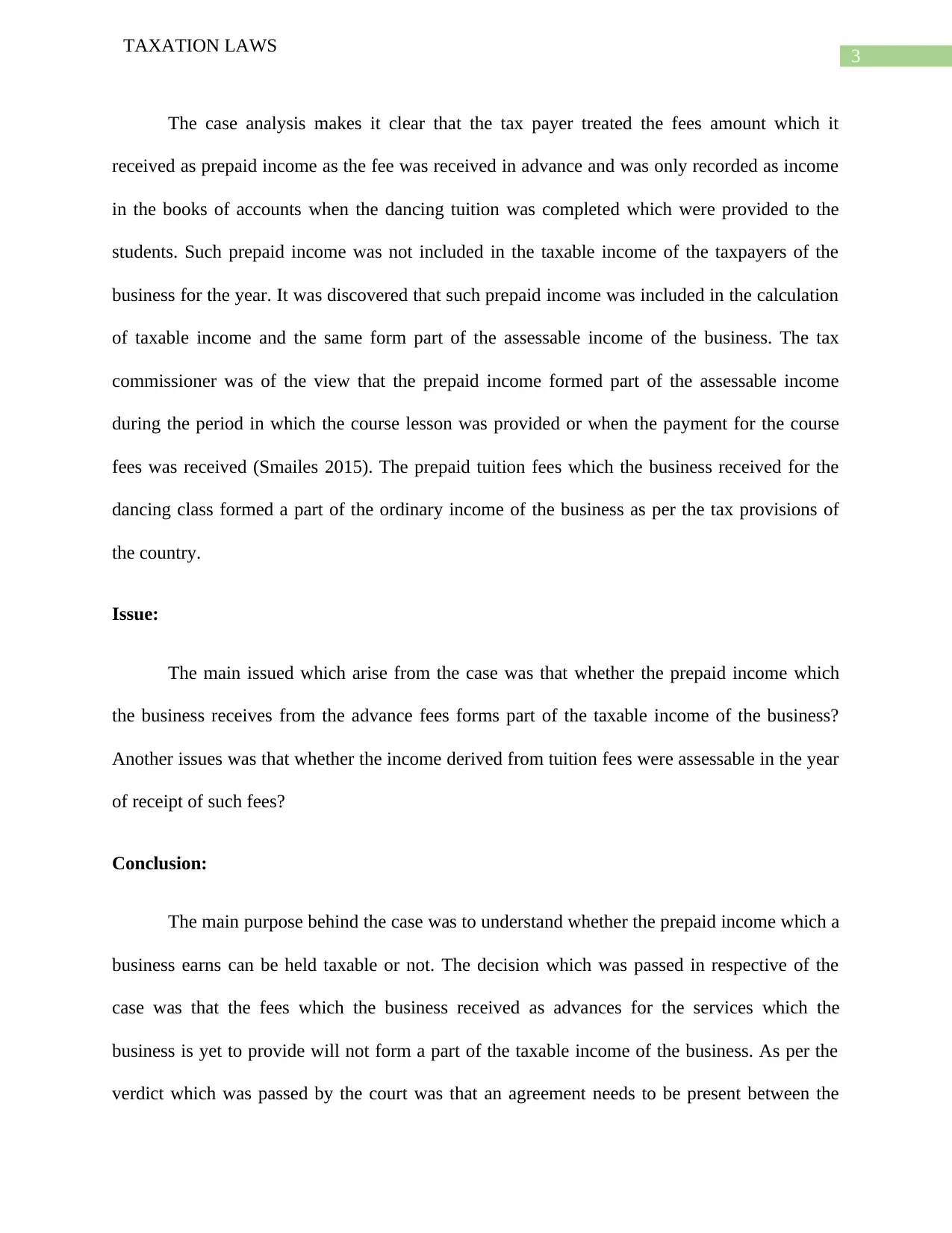
3
TAXATION LAWS
The case analysis makes it clear that the tax payer treated the fees amount which it
received as prepaid income as the fee was received in advance and was only recorded as income
in the books of accounts when the dancing tuition was completed which were provided to the
students. Such prepaid income was not included in the taxable income of the taxpayers of the
business for the year. It was discovered that such prepaid income was included in the calculation
of taxable income and the same form part of the assessable income of the business. The tax
commissioner was of the view that the prepaid income formed part of the assessable income
during the period in which the course lesson was provided or when the payment for the course
fees was received (Smailes 2015). The prepaid tuition fees which the business received for the
dancing class formed a part of the ordinary income of the business as per the tax provisions of
the country.
Issue:
The main issued which arise from the case was that whether the prepaid income which
the business receives from the advance fees forms part of the taxable income of the business?
Another issues was that whether the income derived from tuition fees were assessable in the year
of receipt of such fees?
Conclusion:
The main purpose behind the case was to understand whether the prepaid income which a
business earns can be held taxable or not. The decision which was passed in respective of the
case was that the fees which the business received as advances for the services which the
business is yet to provide will not form a part of the taxable income of the business. As per the
verdict which was passed by the court was that an agreement needs to be present between the
TAXATION LAWS
The case analysis makes it clear that the tax payer treated the fees amount which it
received as prepaid income as the fee was received in advance and was only recorded as income
in the books of accounts when the dancing tuition was completed which were provided to the
students. Such prepaid income was not included in the taxable income of the taxpayers of the
business for the year. It was discovered that such prepaid income was included in the calculation
of taxable income and the same form part of the assessable income of the business. The tax
commissioner was of the view that the prepaid income formed part of the assessable income
during the period in which the course lesson was provided or when the payment for the course
fees was received (Smailes 2015). The prepaid tuition fees which the business received for the
dancing class formed a part of the ordinary income of the business as per the tax provisions of
the country.
Issue:
The main issued which arise from the case was that whether the prepaid income which
the business receives from the advance fees forms part of the taxable income of the business?
Another issues was that whether the income derived from tuition fees were assessable in the year
of receipt of such fees?
Conclusion:
The main purpose behind the case was to understand whether the prepaid income which a
business earns can be held taxable or not. The decision which was passed in respective of the
case was that the fees which the business received as advances for the services which the
business is yet to provide will not form a part of the taxable income of the business. As per the
verdict which was passed by the court was that an agreement needs to be present between the
Paraphrase This Document
Need a fresh take? Get an instant paraphrase of this document with our AI Paraphraser
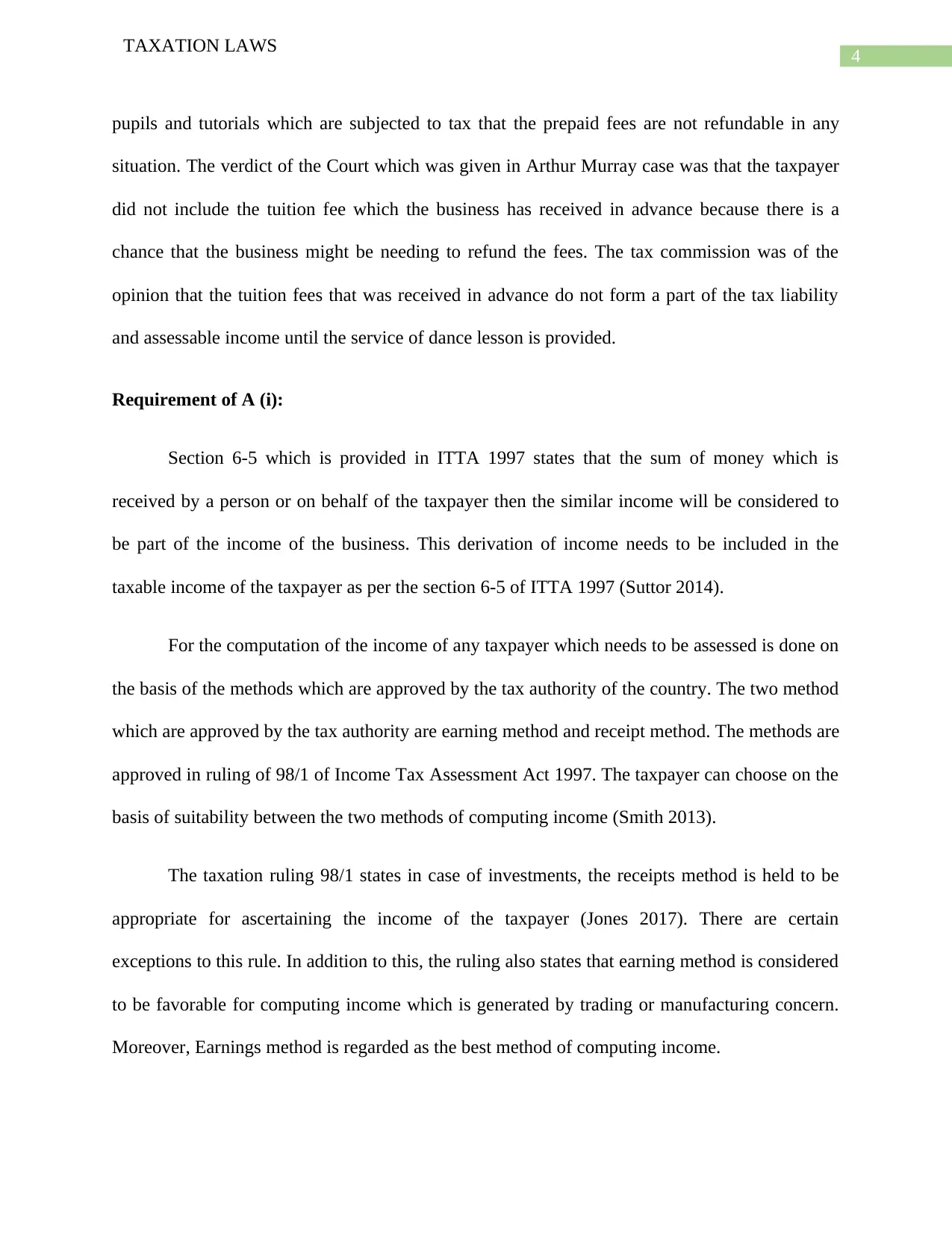
4
TAXATION LAWS
pupils and tutorials which are subjected to tax that the prepaid fees are not refundable in any
situation. The verdict of the Court which was given in Arthur Murray case was that the taxpayer
did not include the tuition fee which the business has received in advance because there is a
chance that the business might be needing to refund the fees. The tax commission was of the
opinion that the tuition fees that was received in advance do not form a part of the tax liability
and assessable income until the service of dance lesson is provided.
Requirement of A (i):
Section 6-5 which is provided in ITTA 1997 states that the sum of money which is
received by a person or on behalf of the taxpayer then the similar income will be considered to
be part of the income of the business. This derivation of income needs to be included in the
taxable income of the taxpayer as per the section 6-5 of ITTA 1997 (Suttor 2014).
For the computation of the income of any taxpayer which needs to be assessed is done on
the basis of the methods which are approved by the tax authority of the country. The two method
which are approved by the tax authority are earning method and receipt method. The methods are
approved in ruling of 98/1 of Income Tax Assessment Act 1997. The taxpayer can choose on the
basis of suitability between the two methods of computing income (Smith 2013).
The taxation ruling 98/1 states in case of investments, the receipts method is held to be
appropriate for ascertaining the income of the taxpayer (Jones 2017). There are certain
exceptions to this rule. In addition to this, the ruling also states that earning method is considered
to be favorable for computing income which is generated by trading or manufacturing concern.
Moreover, Earnings method is regarded as the best method of computing income.
TAXATION LAWS
pupils and tutorials which are subjected to tax that the prepaid fees are not refundable in any
situation. The verdict of the Court which was given in Arthur Murray case was that the taxpayer
did not include the tuition fee which the business has received in advance because there is a
chance that the business might be needing to refund the fees. The tax commission was of the
opinion that the tuition fees that was received in advance do not form a part of the tax liability
and assessable income until the service of dance lesson is provided.
Requirement of A (i):
Section 6-5 which is provided in ITTA 1997 states that the sum of money which is
received by a person or on behalf of the taxpayer then the similar income will be considered to
be part of the income of the business. This derivation of income needs to be included in the
taxable income of the taxpayer as per the section 6-5 of ITTA 1997 (Suttor 2014).
For the computation of the income of any taxpayer which needs to be assessed is done on
the basis of the methods which are approved by the tax authority of the country. The two method
which are approved by the tax authority are earning method and receipt method. The methods are
approved in ruling of 98/1 of Income Tax Assessment Act 1997. The taxpayer can choose on the
basis of suitability between the two methods of computing income (Smith 2013).
The taxation ruling 98/1 states in case of investments, the receipts method is held to be
appropriate for ascertaining the income of the taxpayer (Jones 2017). There are certain
exceptions to this rule. In addition to this, the ruling also states that earning method is considered
to be favorable for computing income which is generated by trading or manufacturing concern.
Moreover, Earnings method is regarded as the best method of computing income.
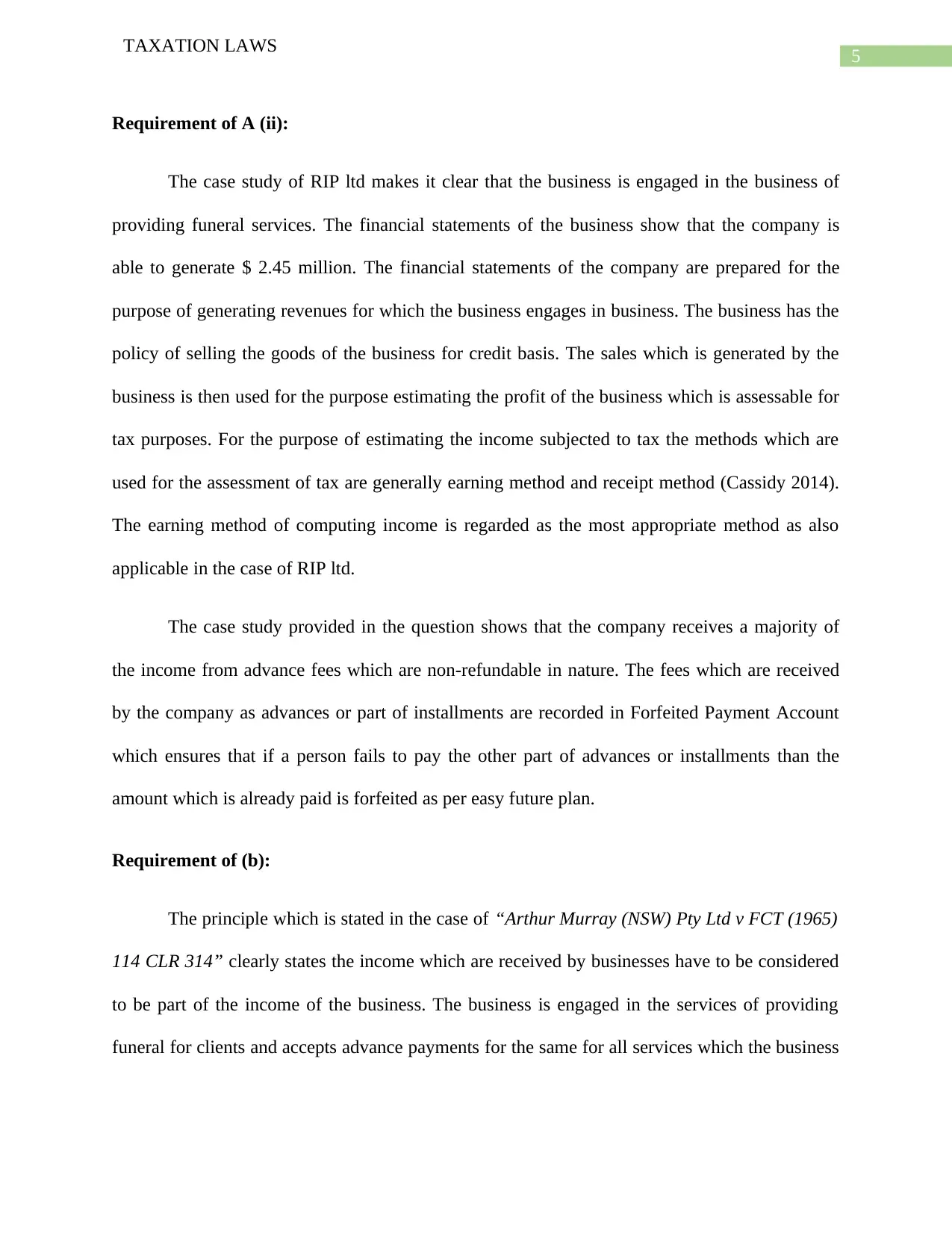
5
TAXATION LAWS
Requirement of A (ii):
The case study of RIP ltd makes it clear that the business is engaged in the business of
providing funeral services. The financial statements of the business show that the company is
able to generate $ 2.45 million. The financial statements of the company are prepared for the
purpose of generating revenues for which the business engages in business. The business has the
policy of selling the goods of the business for credit basis. The sales which is generated by the
business is then used for the purpose estimating the profit of the business which is assessable for
tax purposes. For the purpose of estimating the income subjected to tax the methods which are
used for the assessment of tax are generally earning method and receipt method (Cassidy 2014).
The earning method of computing income is regarded as the most appropriate method as also
applicable in the case of RIP ltd.
The case study provided in the question shows that the company receives a majority of
the income from advance fees which are non-refundable in nature. The fees which are received
by the company as advances or part of installments are recorded in Forfeited Payment Account
which ensures that if a person fails to pay the other part of advances or installments than the
amount which is already paid is forfeited as per easy future plan.
Requirement of (b):
The principle which is stated in the case of “Arthur Murray (NSW) Pty Ltd v FCT (1965)
114 CLR 314” clearly states the income which are received by businesses have to be considered
to be part of the income of the business. The business is engaged in the services of providing
funeral for clients and accepts advance payments for the same for all services which the business
TAXATION LAWS
Requirement of A (ii):
The case study of RIP ltd makes it clear that the business is engaged in the business of
providing funeral services. The financial statements of the business show that the company is
able to generate $ 2.45 million. The financial statements of the company are prepared for the
purpose of generating revenues for which the business engages in business. The business has the
policy of selling the goods of the business for credit basis. The sales which is generated by the
business is then used for the purpose estimating the profit of the business which is assessable for
tax purposes. For the purpose of estimating the income subjected to tax the methods which are
used for the assessment of tax are generally earning method and receipt method (Cassidy 2014).
The earning method of computing income is regarded as the most appropriate method as also
applicable in the case of RIP ltd.
The case study provided in the question shows that the company receives a majority of
the income from advance fees which are non-refundable in nature. The fees which are received
by the company as advances or part of installments are recorded in Forfeited Payment Account
which ensures that if a person fails to pay the other part of advances or installments than the
amount which is already paid is forfeited as per easy future plan.
Requirement of (b):
The principle which is stated in the case of “Arthur Murray (NSW) Pty Ltd v FCT (1965)
114 CLR 314” clearly states the income which are received by businesses have to be considered
to be part of the income of the business. The business is engaged in the services of providing
funeral for clients and accepts advance payments for the same for all services which the business
⊘ This is a preview!⊘
Do you want full access?
Subscribe today to unlock all pages.

Trusted by 1+ million students worldwide
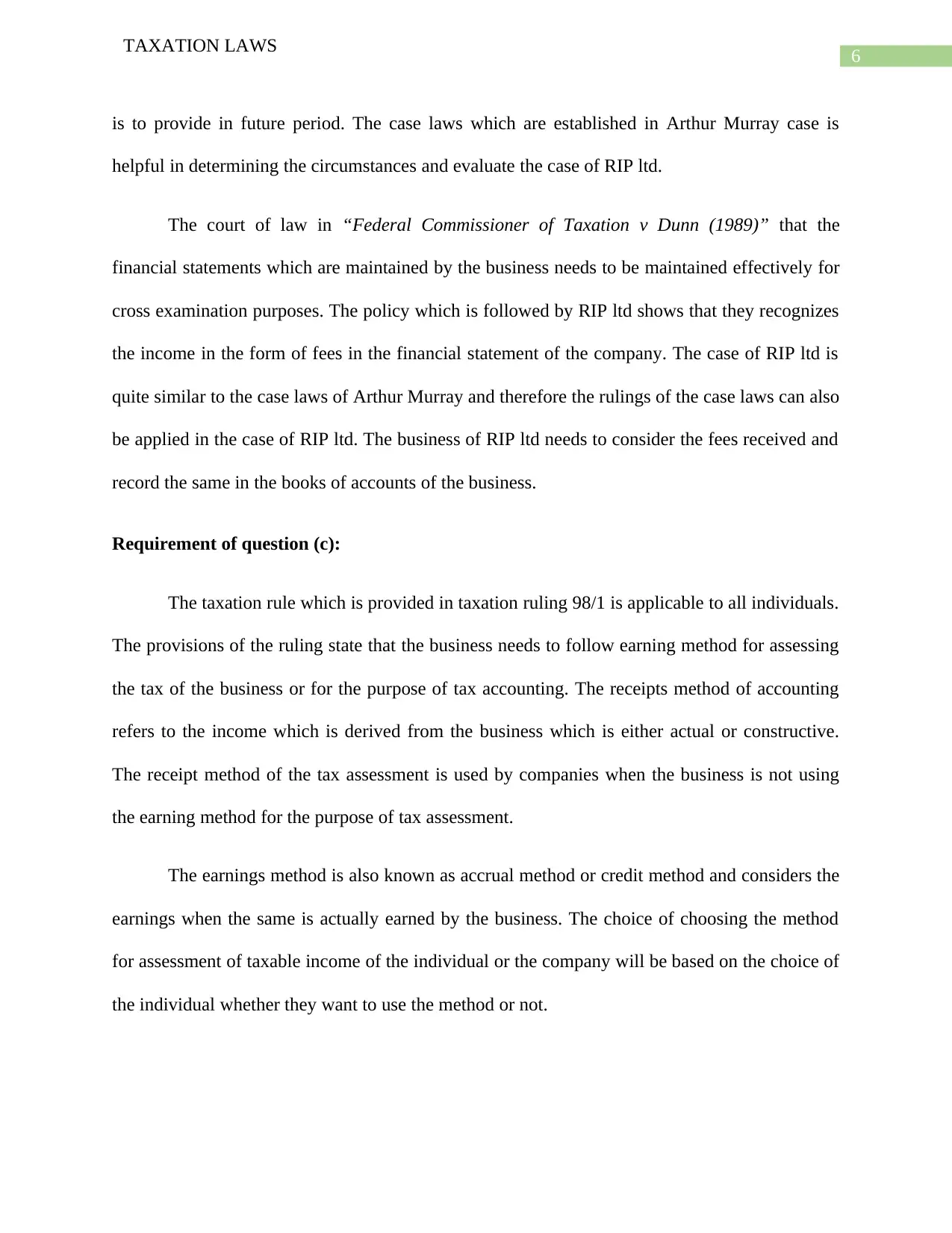
6
TAXATION LAWS
is to provide in future period. The case laws which are established in Arthur Murray case is
helpful in determining the circumstances and evaluate the case of RIP ltd.
The court of law in “Federal Commissioner of Taxation v Dunn (1989)” that the
financial statements which are maintained by the business needs to be maintained effectively for
cross examination purposes. The policy which is followed by RIP ltd shows that they recognizes
the income in the form of fees in the financial statement of the company. The case of RIP ltd is
quite similar to the case laws of Arthur Murray and therefore the rulings of the case laws can also
be applied in the case of RIP ltd. The business of RIP ltd needs to consider the fees received and
record the same in the books of accounts of the business.
Requirement of question (c):
The taxation rule which is provided in taxation ruling 98/1 is applicable to all individuals.
The provisions of the ruling state that the business needs to follow earning method for assessing
the tax of the business or for the purpose of tax accounting. The receipts method of accounting
refers to the income which is derived from the business which is either actual or constructive.
The receipt method of the tax assessment is used by companies when the business is not using
the earning method for the purpose of tax assessment.
The earnings method is also known as accrual method or credit method and considers the
earnings when the same is actually earned by the business. The choice of choosing the method
for assessment of taxable income of the individual or the company will be based on the choice of
the individual whether they want to use the method or not.
TAXATION LAWS
is to provide in future period. The case laws which are established in Arthur Murray case is
helpful in determining the circumstances and evaluate the case of RIP ltd.
The court of law in “Federal Commissioner of Taxation v Dunn (1989)” that the
financial statements which are maintained by the business needs to be maintained effectively for
cross examination purposes. The policy which is followed by RIP ltd shows that they recognizes
the income in the form of fees in the financial statement of the company. The case of RIP ltd is
quite similar to the case laws of Arthur Murray and therefore the rulings of the case laws can also
be applied in the case of RIP ltd. The business of RIP ltd needs to consider the fees received and
record the same in the books of accounts of the business.
Requirement of question (c):
The taxation rule which is provided in taxation ruling 98/1 is applicable to all individuals.
The provisions of the ruling state that the business needs to follow earning method for assessing
the tax of the business or for the purpose of tax accounting. The receipts method of accounting
refers to the income which is derived from the business which is either actual or constructive.
The receipt method of the tax assessment is used by companies when the business is not using
the earning method for the purpose of tax assessment.
The earnings method is also known as accrual method or credit method and considers the
earnings when the same is actually earned by the business. The choice of choosing the method
for assessment of taxable income of the individual or the company will be based on the choice of
the individual whether they want to use the method or not.
Paraphrase This Document
Need a fresh take? Get an instant paraphrase of this document with our AI Paraphraser
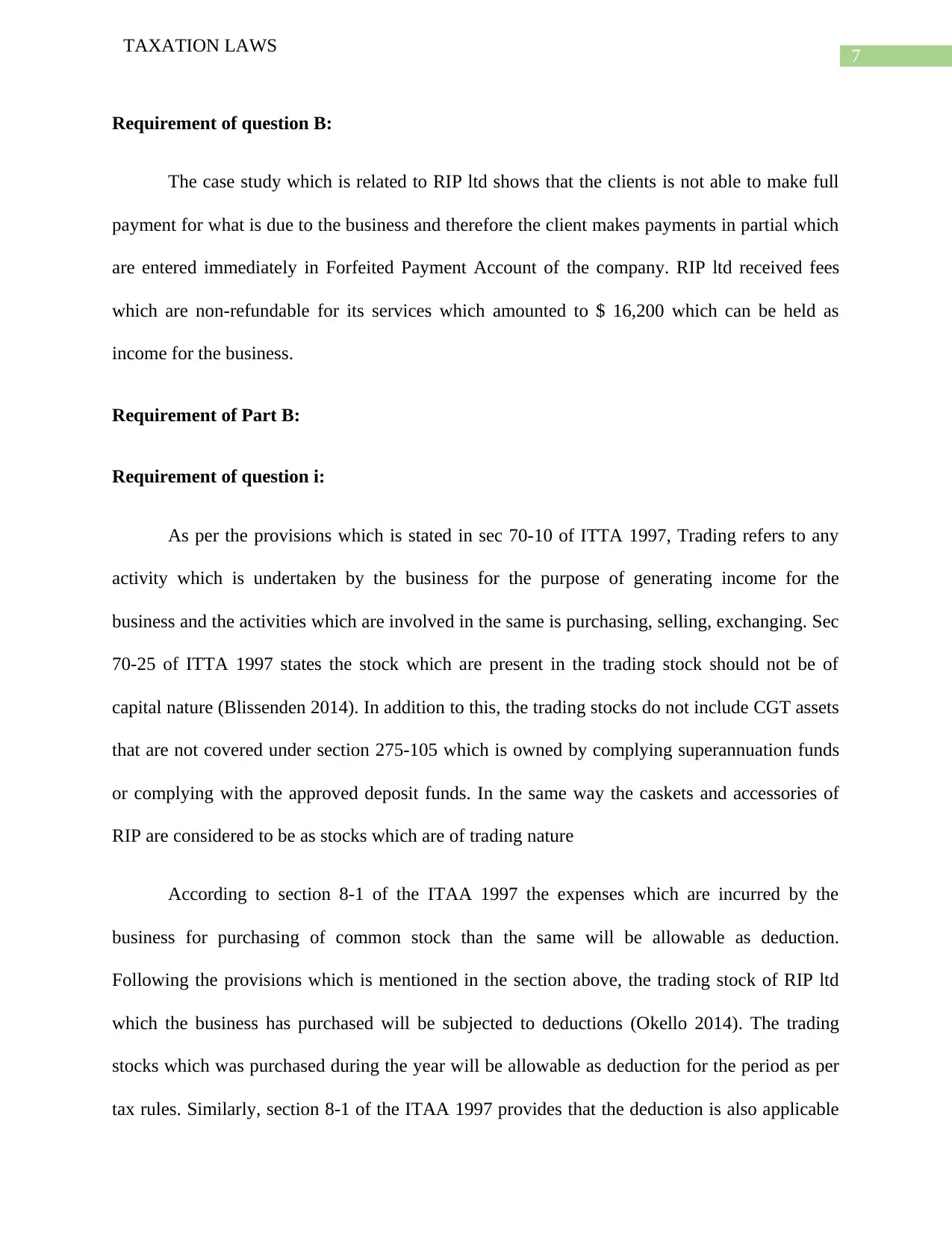
7
TAXATION LAWS
Requirement of question B:
The case study which is related to RIP ltd shows that the clients is not able to make full
payment for what is due to the business and therefore the client makes payments in partial which
are entered immediately in Forfeited Payment Account of the company. RIP ltd received fees
which are non-refundable for its services which amounted to $ 16,200 which can be held as
income for the business.
Requirement of Part B:
Requirement of question i:
As per the provisions which is stated in sec 70-10 of ITTA 1997, Trading refers to any
activity which is undertaken by the business for the purpose of generating income for the
business and the activities which are involved in the same is purchasing, selling, exchanging. Sec
70-25 of ITTA 1997 states the stock which are present in the trading stock should not be of
capital nature (Blissenden 2014). In addition to this, the trading stocks do not include CGT assets
that are not covered under section 275-105 which is owned by complying superannuation funds
or complying with the approved deposit funds. In the same way the caskets and accessories of
RIP are considered to be as stocks which are of trading nature
According to section 8-1 of the ITAA 1997 the expenses which are incurred by the
business for purchasing of common stock than the same will be allowable as deduction.
Following the provisions which is mentioned in the section above, the trading stock of RIP ltd
which the business has purchased will be subjected to deductions (Okello 2014). The trading
stocks which was purchased during the year will be allowable as deduction for the period as per
tax rules. Similarly, section 8-1 of the ITAA 1997 provides that the deduction is also applicable
TAXATION LAWS
Requirement of question B:
The case study which is related to RIP ltd shows that the clients is not able to make full
payment for what is due to the business and therefore the client makes payments in partial which
are entered immediately in Forfeited Payment Account of the company. RIP ltd received fees
which are non-refundable for its services which amounted to $ 16,200 which can be held as
income for the business.
Requirement of Part B:
Requirement of question i:
As per the provisions which is stated in sec 70-10 of ITTA 1997, Trading refers to any
activity which is undertaken by the business for the purpose of generating income for the
business and the activities which are involved in the same is purchasing, selling, exchanging. Sec
70-25 of ITTA 1997 states the stock which are present in the trading stock should not be of
capital nature (Blissenden 2014). In addition to this, the trading stocks do not include CGT assets
that are not covered under section 275-105 which is owned by complying superannuation funds
or complying with the approved deposit funds. In the same way the caskets and accessories of
RIP are considered to be as stocks which are of trading nature
According to section 8-1 of the ITAA 1997 the expenses which are incurred by the
business for purchasing of common stock than the same will be allowable as deduction.
Following the provisions which is mentioned in the section above, the trading stock of RIP ltd
which the business has purchased will be subjected to deductions (Okello 2014). The trading
stocks which was purchased during the year will be allowable as deduction for the period as per
tax rules. Similarly, section 8-1 of the ITAA 1997 provides that the deduction is also applicable
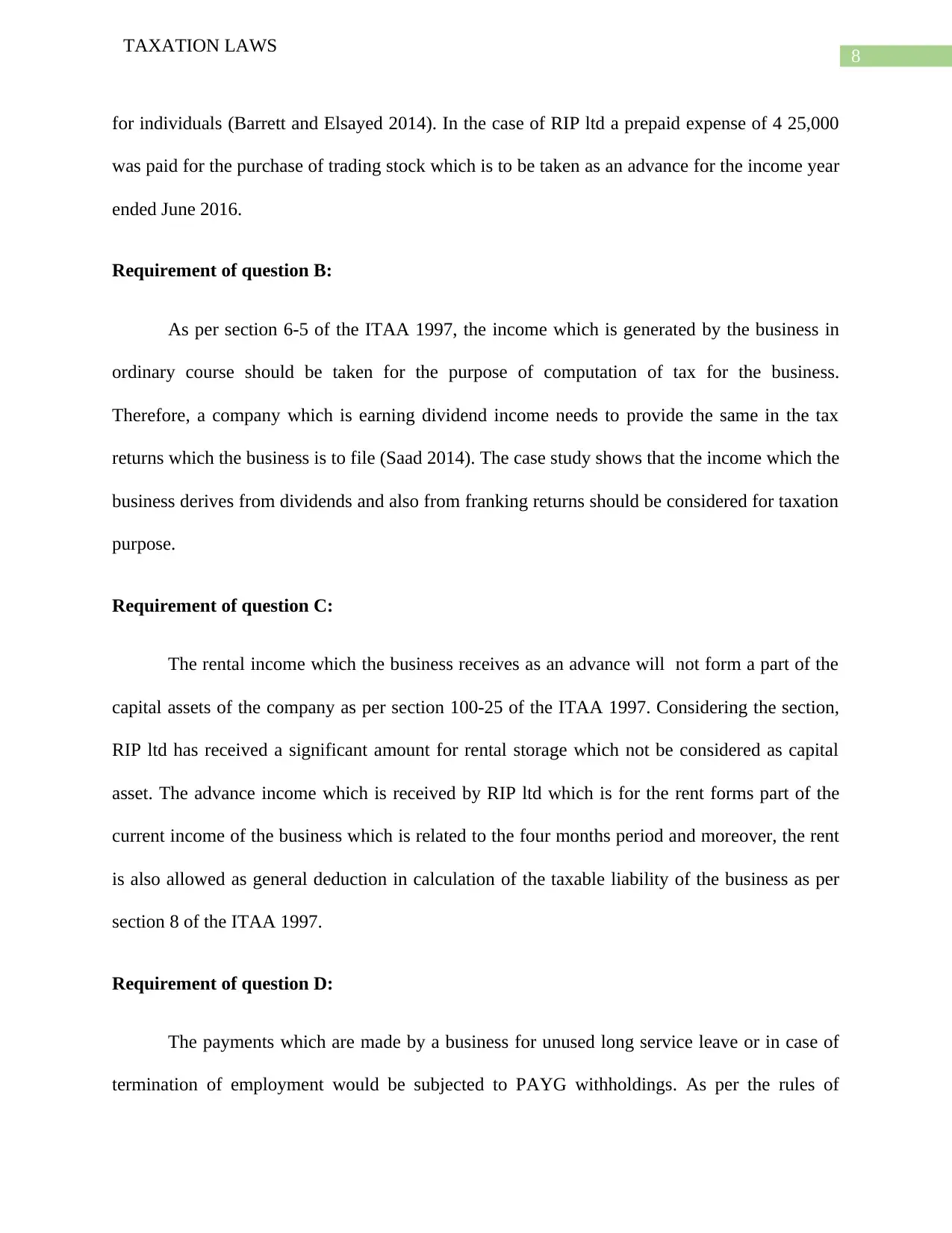
8
TAXATION LAWS
for individuals (Barrett and Elsayed 2014). In the case of RIP ltd a prepaid expense of 4 25,000
was paid for the purchase of trading stock which is to be taken as an advance for the income year
ended June 2016.
Requirement of question B:
As per section 6-5 of the ITAA 1997, the income which is generated by the business in
ordinary course should be taken for the purpose of computation of tax for the business.
Therefore, a company which is earning dividend income needs to provide the same in the tax
returns which the business is to file (Saad 2014). The case study shows that the income which the
business derives from dividends and also from franking returns should be considered for taxation
purpose.
Requirement of question C:
The rental income which the business receives as an advance will not form a part of the
capital assets of the company as per section 100-25 of the ITAA 1997. Considering the section,
RIP ltd has received a significant amount for rental storage which not be considered as capital
asset. The advance income which is received by RIP ltd which is for the rent forms part of the
current income of the business which is related to the four months period and moreover, the rent
is also allowed as general deduction in calculation of the taxable liability of the business as per
section 8 of the ITAA 1997.
Requirement of question D:
The payments which are made by a business for unused long service leave or in case of
termination of employment would be subjected to PAYG withholdings. As per the rules of
TAXATION LAWS
for individuals (Barrett and Elsayed 2014). In the case of RIP ltd a prepaid expense of 4 25,000
was paid for the purchase of trading stock which is to be taken as an advance for the income year
ended June 2016.
Requirement of question B:
As per section 6-5 of the ITAA 1997, the income which is generated by the business in
ordinary course should be taken for the purpose of computation of tax for the business.
Therefore, a company which is earning dividend income needs to provide the same in the tax
returns which the business is to file (Saad 2014). The case study shows that the income which the
business derives from dividends and also from franking returns should be considered for taxation
purpose.
Requirement of question C:
The rental income which the business receives as an advance will not form a part of the
capital assets of the company as per section 100-25 of the ITAA 1997. Considering the section,
RIP ltd has received a significant amount for rental storage which not be considered as capital
asset. The advance income which is received by RIP ltd which is for the rent forms part of the
current income of the business which is related to the four months period and moreover, the rent
is also allowed as general deduction in calculation of the taxable liability of the business as per
section 8 of the ITAA 1997.
Requirement of question D:
The payments which are made by a business for unused long service leave or in case of
termination of employment would be subjected to PAYG withholdings. As per the rules of
⊘ This is a preview!⊘
Do you want full access?
Subscribe today to unlock all pages.

Trusted by 1+ million students worldwide
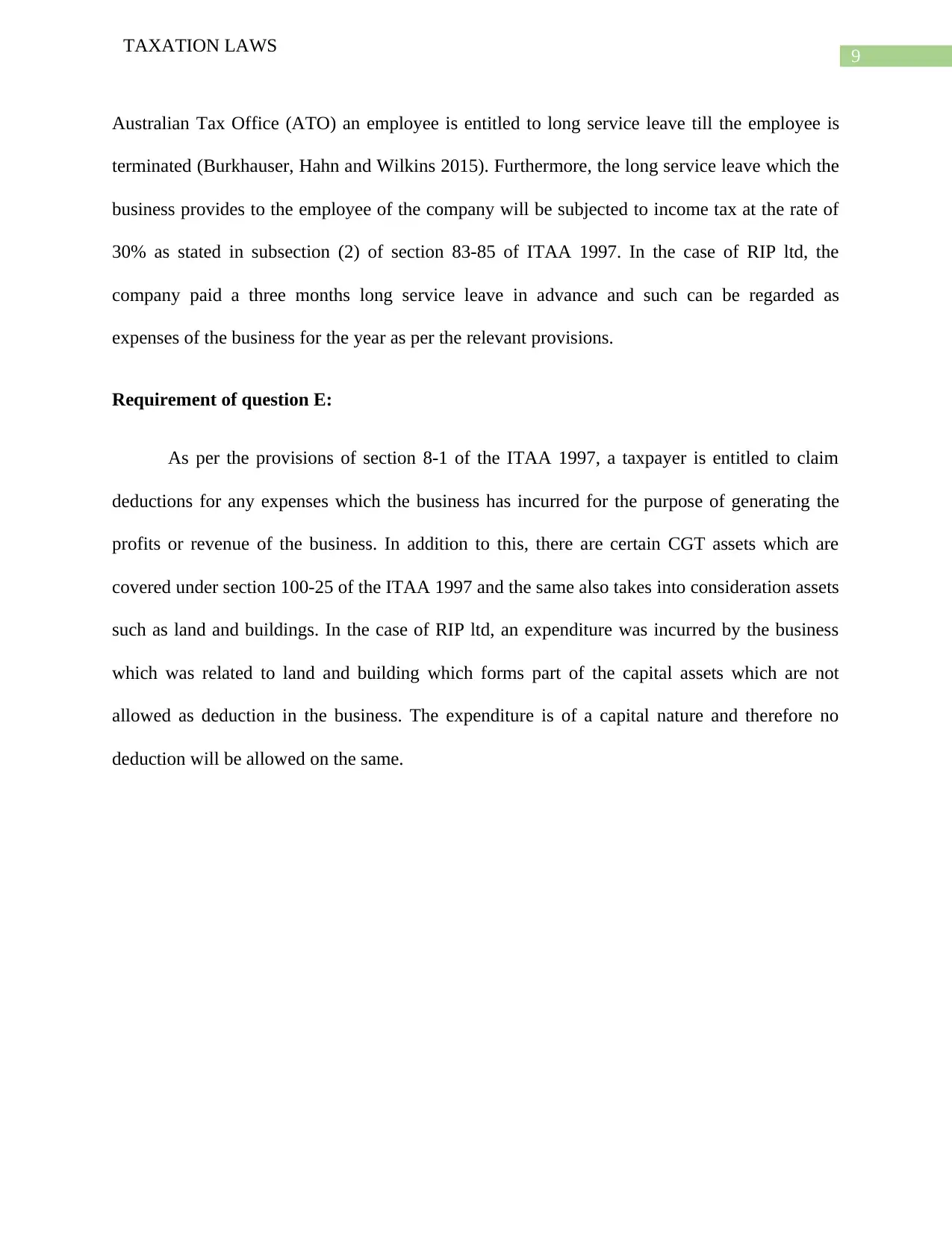
9
TAXATION LAWS
Australian Tax Office (ATO) an employee is entitled to long service leave till the employee is
terminated (Burkhauser, Hahn and Wilkins 2015). Furthermore, the long service leave which the
business provides to the employee of the company will be subjected to income tax at the rate of
30% as stated in subsection (2) of section 83-85 of ITAA 1997. In the case of RIP ltd, the
company paid a three months long service leave in advance and such can be regarded as
expenses of the business for the year as per the relevant provisions.
Requirement of question E:
As per the provisions of section 8-1 of the ITAA 1997, a taxpayer is entitled to claim
deductions for any expenses which the business has incurred for the purpose of generating the
profits or revenue of the business. In addition to this, there are certain CGT assets which are
covered under section 100-25 of the ITAA 1997 and the same also takes into consideration assets
such as land and buildings. In the case of RIP ltd, an expenditure was incurred by the business
which was related to land and building which forms part of the capital assets which are not
allowed as deduction in the business. The expenditure is of a capital nature and therefore no
deduction will be allowed on the same.
TAXATION LAWS
Australian Tax Office (ATO) an employee is entitled to long service leave till the employee is
terminated (Burkhauser, Hahn and Wilkins 2015). Furthermore, the long service leave which the
business provides to the employee of the company will be subjected to income tax at the rate of
30% as stated in subsection (2) of section 83-85 of ITAA 1997. In the case of RIP ltd, the
company paid a three months long service leave in advance and such can be regarded as
expenses of the business for the year as per the relevant provisions.
Requirement of question E:
As per the provisions of section 8-1 of the ITAA 1997, a taxpayer is entitled to claim
deductions for any expenses which the business has incurred for the purpose of generating the
profits or revenue of the business. In addition to this, there are certain CGT assets which are
covered under section 100-25 of the ITAA 1997 and the same also takes into consideration assets
such as land and buildings. In the case of RIP ltd, an expenditure was incurred by the business
which was related to land and building which forms part of the capital assets which are not
allowed as deduction in the business. The expenditure is of a capital nature and therefore no
deduction will be allowed on the same.
Paraphrase This Document
Need a fresh take? Get an instant paraphrase of this document with our AI Paraphraser
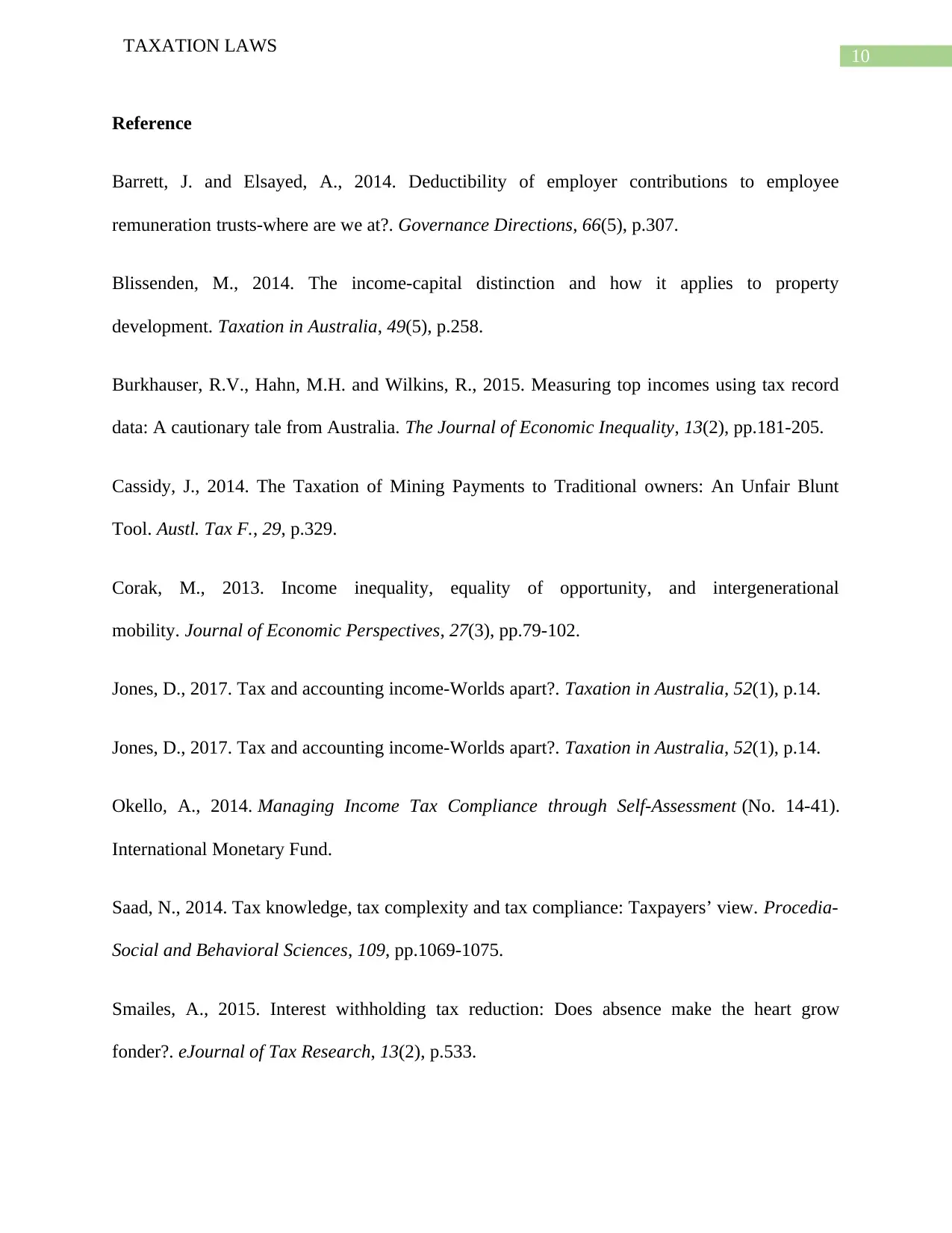
10
TAXATION LAWS
Reference
Barrett, J. and Elsayed, A., 2014. Deductibility of employer contributions to employee
remuneration trusts-where are we at?. Governance Directions, 66(5), p.307.
Blissenden, M., 2014. The income-capital distinction and how it applies to property
development. Taxation in Australia, 49(5), p.258.
Burkhauser, R.V., Hahn, M.H. and Wilkins, R., 2015. Measuring top incomes using tax record
data: A cautionary tale from Australia. The Journal of Economic Inequality, 13(2), pp.181-205.
Cassidy, J., 2014. The Taxation of Mining Payments to Traditional owners: An Unfair Blunt
Tool. Austl. Tax F., 29, p.329.
Corak, M., 2013. Income inequality, equality of opportunity, and intergenerational
mobility. Journal of Economic Perspectives, 27(3), pp.79-102.
Jones, D., 2017. Tax and accounting income-Worlds apart?. Taxation in Australia, 52(1), p.14.
Jones, D., 2017. Tax and accounting income-Worlds apart?. Taxation in Australia, 52(1), p.14.
Okello, A., 2014. Managing Income Tax Compliance through Self-Assessment (No. 14-41).
International Monetary Fund.
Saad, N., 2014. Tax knowledge, tax complexity and tax compliance: Taxpayers’ view. Procedia-
Social and Behavioral Sciences, 109, pp.1069-1075.
Smailes, A., 2015. Interest withholding tax reduction: Does absence make the heart grow
fonder?. eJournal of Tax Research, 13(2), p.533.
TAXATION LAWS
Reference
Barrett, J. and Elsayed, A., 2014. Deductibility of employer contributions to employee
remuneration trusts-where are we at?. Governance Directions, 66(5), p.307.
Blissenden, M., 2014. The income-capital distinction and how it applies to property
development. Taxation in Australia, 49(5), p.258.
Burkhauser, R.V., Hahn, M.H. and Wilkins, R., 2015. Measuring top incomes using tax record
data: A cautionary tale from Australia. The Journal of Economic Inequality, 13(2), pp.181-205.
Cassidy, J., 2014. The Taxation of Mining Payments to Traditional owners: An Unfair Blunt
Tool. Austl. Tax F., 29, p.329.
Corak, M., 2013. Income inequality, equality of opportunity, and intergenerational
mobility. Journal of Economic Perspectives, 27(3), pp.79-102.
Jones, D., 2017. Tax and accounting income-Worlds apart?. Taxation in Australia, 52(1), p.14.
Jones, D., 2017. Tax and accounting income-Worlds apart?. Taxation in Australia, 52(1), p.14.
Okello, A., 2014. Managing Income Tax Compliance through Self-Assessment (No. 14-41).
International Monetary Fund.
Saad, N., 2014. Tax knowledge, tax complexity and tax compliance: Taxpayers’ view. Procedia-
Social and Behavioral Sciences, 109, pp.1069-1075.
Smailes, A., 2015. Interest withholding tax reduction: Does absence make the heart grow
fonder?. eJournal of Tax Research, 13(2), p.533.
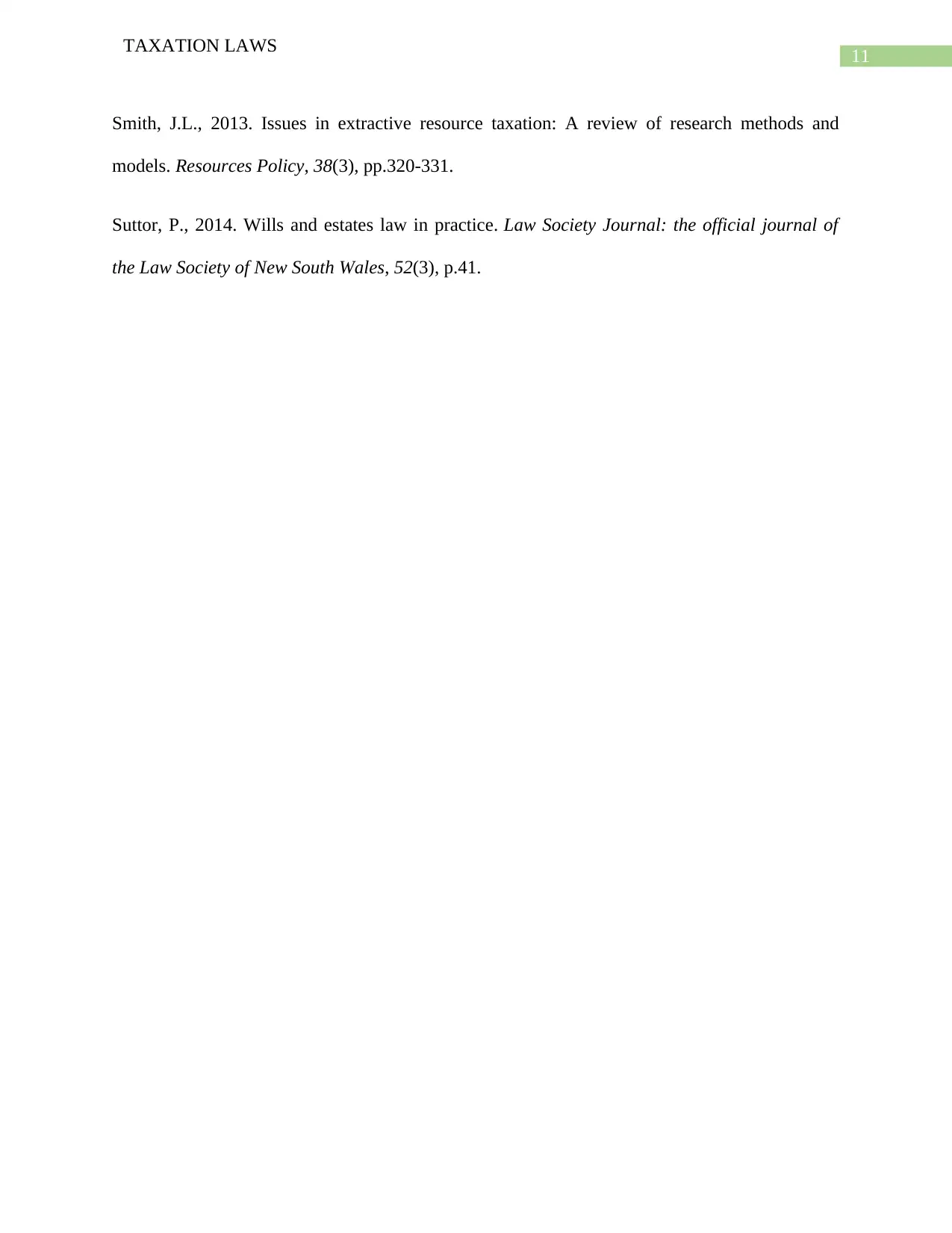
11
TAXATION LAWS
Smith, J.L., 2013. Issues in extractive resource taxation: A review of research methods and
models. Resources Policy, 38(3), pp.320-331.
Suttor, P., 2014. Wills and estates law in practice. Law Society Journal: the official journal of
the Law Society of New South Wales, 52(3), p.41.
TAXATION LAWS
Smith, J.L., 2013. Issues in extractive resource taxation: A review of research methods and
models. Resources Policy, 38(3), pp.320-331.
Suttor, P., 2014. Wills and estates law in practice. Law Society Journal: the official journal of
the Law Society of New South Wales, 52(3), p.41.
⊘ This is a preview!⊘
Do you want full access?
Subscribe today to unlock all pages.

Trusted by 1+ million students worldwide
1 out of 12
Related Documents
Your All-in-One AI-Powered Toolkit for Academic Success.
+13062052269
info@desklib.com
Available 24*7 on WhatsApp / Email
![[object Object]](/_next/static/media/star-bottom.7253800d.svg)
Unlock your academic potential
Copyright © 2020–2025 A2Z Services. All Rights Reserved. Developed and managed by ZUCOL.




